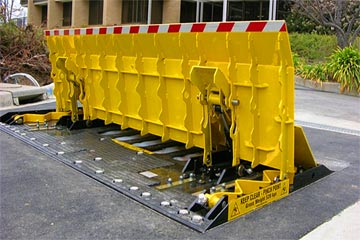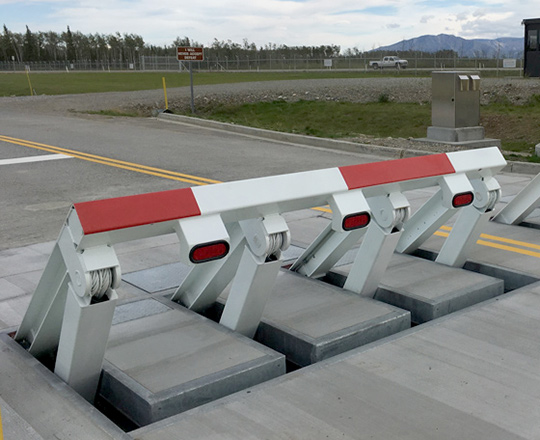The Facts About Wedge Barriers Uncovered
Table of ContentsThe Basic Principles Of Wedge Barriers The Wedge Barriers PDFs

How Wedge Barriers can Save You Time, Stress, and Money.
The continuing to be pressure applied to
the cam camera deploy the wedge plate 16 may might provided offered an electromechanical actuator 84 or other actuator. The spring assembly 54 and the actuator 84(e. Wedge Barriers. g., electromechanical actuator)may operate together to equate the web cam and raise the wedge plate 16.
As discussed over, the springtime assembly 54 exerts a continuous force on the cam, while the electromechanical actuator may be managed to put in a variable force on the web cam, thus making it possible for the training and reducing( i. e., releasing and withdrawing )of the wedge plate 16. In particular personifications, the constant force applied by the spring setting up 54 might be flexible. g., electromechanical actuator) is impaired. As will certainly be valued, the spring setting up 54 may be covered and safeguarded from debris or other elements by a cover plate(e. g., cover plate 68 received FIG. 4) that may be considerably flush with the elevated surface area 38 of the structure 14. As pointed out above, in the released setting, the wedge plate 16 serves to block accessibility or traveling past the barrier 10. For example, the obstacle 10(e. g., the wedge plate 16 )might obstruct pedestrians or automobiles from accessing a property or path. As reviewed above, the barrier 10 is connected to the support 30 protected within the structure 14,

front brackets 71. As a result, the linkage settings up 72 might pivot and revolve to enable the collapse and extension of the link settings up 72 throughout retraction and release of the bather 10. The affiliation settings up 72 reason activity of the wedge plate 16 to be limited. If a visit this page car is important source traveling towards the deployed wedge plate 16(e. For instance, in one situation, the safety and security legs 86 might be expanded duringmaintenance of the barrier 10. When the security legs 86 are deployed, the safety and security legs 86 sustain the weight of the wedge plate 16 against the surface 12. Because of this, the training system 50 may be deactivated, serviced, eliminated, replaced, etc. FIG. 5 is partial perspective sight of a personification of the surface-mounted wedge-style barrier 10, illustrating the cam 80 and the cam surface areas 82 of the lifting device 50. Particularly, two cam surfaces 82, which are described as reduced cam surface areas 83, are positioned below the web cam 80. The lower cam surfaces 83 might be dealt with to the surface area 12 (e. As an example, the lower cam surface areas 83 and the installing plate 85 might create a solitary piece that is secured to the support 30 by screws or various other mechanical bolts. Furthermore, 2 webcam surfaces 82, which are described as upper web cam surfaces 87, are positioned above the web advice cam 80 and coupled to (e. In various other embodiments, intervening layers or plates might be positioned in between the surface 12 and the reduced webcam surfaces 83 and/or the wedge plate 16 and the upper cam surfaces 87 As discussed over, the cam
80 equates along the webcam surfaces 82 when the wedge plate 16 is lifted from the withdrawed position to the released position. Furthermore, as mentioned above, the springtime assembly 54 (see FIG. 3 )might supply a pressure acting on the web cam 80 in the instructions 102 through spring rod 58, which may minimize the force the electromechanical actuator 84 is called for to apply to the camera 80 in order to activate and raise the wedge plate 16. 1 )to the released placement(see FIG. 4). As shown, the webcam 80 consists of track wheels 104(e. g., rollers), which call and translate along the web cam surface areas 82 throughout procedure.